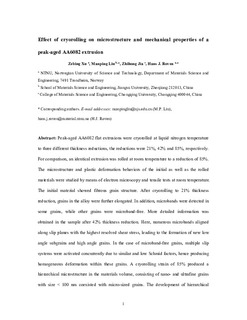| dc.contributor.author | Xu, Zebing | |
| dc.contributor.author | Liu, Manping | |
| dc.contributor.author | Jia, Zhihong | |
| dc.contributor.author | Roven, Hans Jørgen | |
| dc.date.accessioned | 2018-01-22T10:18:03Z | |
| dc.date.available | 2018-01-22T10:18:03Z | |
| dc.date.created | 2017-01-10T11:21:59Z | |
| dc.date.issued | 2017 | |
| dc.identifier.citation | Journal of Alloys and Compounds. 2017, 695 827-840. | nb_NO |
| dc.identifier.issn | 0925-8388 | |
| dc.identifier.uri | http://hdl.handle.net/11250/2478651 | |
| dc.description.abstract | Peak-aged AA6082 flat extrusions were cryorolled at liquid nitrogen temperature to three different thickness reductions, the reductions were 21%, 42% and 85%, respectively. Microstructure and plastic deformation behaviors of the initial as well as the rolled materials were studied by means of scanning electron microscopy (SEM), electron backscatter diffraction (EBSD), transmission electron microscopy (TEM) and tensile tests at room temperature. The initial material showed fibrous grain structure. After cryorolling to 21% thickness reduction, grains in the alloy were obviously elongated and importantly, microband traces were detected in selected grains. More detailed information was obtained in the alloy after 42% thickness reduction. Here, numerous microbands aligned along slip planes with the highest resolved shear stress, producing fragmentation of grains, while rests of elongated grains were microband-free. A cryorolling strain of 85% has been found to be desirable for producing a hierarchical microstructure in the materials volume, featuring nano- and ultrafine grains with size <100 nm coexisted with micro-sized grains. The development of hierarchical microstructure could be considered as a consequence of the intersection between families of microbands. As a result, both the strength and uniform elongation of the severely cryorolled alloy, i.e. 85% thickness reduction, were more superior to other rolled alloys. Therefore, this study revealed that the single processing procedure, i.e., cryorolling, can be utilized to tailor for desired properties in favor of both strength and ductility for peak-aged AA6082 extrusions. | nb_NO |
| dc.language.iso | eng | nb_NO |
| dc.publisher | Elsevier | nb_NO |
| dc.rights | Attribution-NonCommercial-NoDerivatives 4.0 Internasjonal | * |
| dc.rights.uri | http://creativecommons.org/licenses/by-nc-nd/4.0/deed.no | * |
| dc.title | Effect of cryorolling on microstructure and mechanical properties of a peak-aged AA6082 extrusion | nb_NO |
| dc.type | Journal article | nb_NO |
| dc.type | Peer reviewed | nb_NO |
| dc.description.version | acceptedVersion | nb_NO |
| dc.source.pagenumber | 827-840 | nb_NO |
| dc.source.volume | 695 | nb_NO |
| dc.source.journal | Journal of Alloys and Compounds | nb_NO |
| dc.identifier.doi | 10.1016/j.jallcom.2016.10.135 | |
| dc.identifier.cristin | 1424090 | |
| dc.description.localcode | © 2016. This is the authors’ accepted and refereed manuscript to the article. Locked until 17.10.2018 due to copyright restrictions. This manuscript version is made available under the CC-BY-NC-ND 4.0 license http://creativecommons.org/licenses/by-nc-nd/4.0/ | nb_NO |
| cristin.unitcode | 194,66,35,0 | |
| cristin.unitname | Institutt for materialteknologi | |
| cristin.ispublished | true | |
| cristin.fulltext | postprint | |
| cristin.qualitycode | 1 | |

